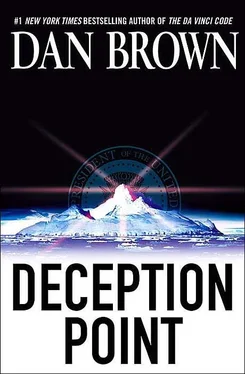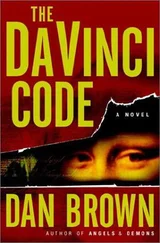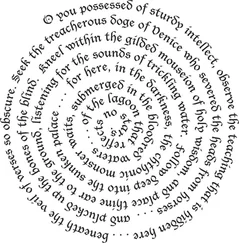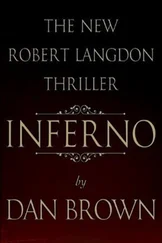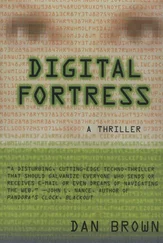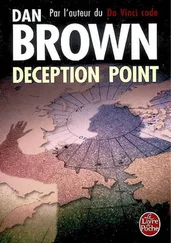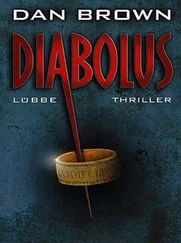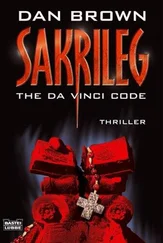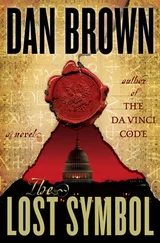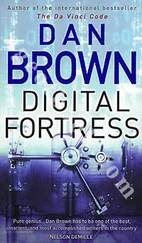Wailee Ming. Norah Mangor. Both dead.
The bold kill that had just taken place at the FDR Memorial.
Soon to be added to the list were Rachel Sexton, Michael Tolland, and Dr. Marlinson.
There is no other way, the controller thought, fighting the growing remorse. Far too much is at stake.
The Coast Guard Dolphin was still two miles from the Goya ’s coordinates and flying at three thousand feet when Tolland yelled up to the pilot.
“Do you have NightSight onboard this thing?”
The pilot nodded. “I’m a rescue unit.”
Tolland had expected as much. NightSight was Raytheon’s marine thermal imaging system, capable of locating wreck survivors in the dark. The heat given off by a swimmer’s head would appear as a red speck on an ocean of black.
“Switch it on,” Tolland said.
The pilot looked confused. “Why? You missing someone?”
“No. I want everyone to see something.”
“We won’t see a thing on thermal from this high up unless there’s a burning oil slick.”
“Just switch it on,” Tolland said.
The pilot gave Tolland an odd look and then adjusted some dials, commanding the thermal lens beneath the chopper to survey a three-mile swatch of ocean in front of them. An LCD screen on his dashboard lit up. The image came into focus.
“Holy shit!” The helicopter lurched momentarily as the pilot recoiled in surprise and then recovered, staring at the screen.
Rachel and Corky leaned forward, looking at the image with equal surprise. The black background of the ocean was illuminated by an enormous swirling spiral of pulsating red.
Rachel turned to Tolland with trepidation. “It looks like a cyclone.”
“It is,” Tolland said. “A cyclone of warm currents. About a half mile across.”
The Coast Guard pilot chuckled in amazement. “That’s a big one. We see these now and then, but I hadn’t heard about this one yet.”
“Just surfaced last week,” Tolland said. “Probably won’t last more than another few days.”
“What causes it?” Rachel asked, understandably perplexed by the huge vortex of swirling water in the middle of the ocean.
“Magma dome,” the pilot said.
Rachel turned to Tolland, looking wary. “A volcano?”
“No,” Tolland said. “The East Coast typically doesn’t have active volcanoes, but occasionally we get rogue pockets of magma that well up under the seafloor and cause hot spots. The hot spot causes a reverse temperature gradient—hot water on the bottom and cooler water on top. It results in these giant spiral currents. They’re called megaplumes. They spin for a couple of weeks and then dissipate.”
The pilot looked at the pulsating spiral on his LCD screen. “Looks like this one’s still going strong.” He paused, checking the coordinates of Tolland’s ship, and then looked over his shoulder in surprise. “Mr. Tolland, it looks like you’re parked fairly near the middle of it.”
Tolland nodded. “Currents are a little slower near the eye. Eighteen knots. Like anchoring in a fast-moving river. Our chain’s been getting a real workout this week.”
“Jesus,” the pilot said. “Eighteen-knot current? Don’t fall overboard!” He laughed.
Rachel did not laugh. “Mike, you didn’t mention this megaplume, magma dome, hot-current situation.”
He put a reassuring hand on her knee. “It’s perfectly safe, trust me.”
Rachel frowned. “So this documentary you were making out here was about this magma dome phenomenon?”
“Megaplumes and Sphyrna mokarran.”
“That’s right. You mentioned that earlier.”
Tolland gave a coy smile. “Sphyrna mokarran love warm water, and right now, every last one for a hundred miles is congregating in this mile-wide circle of heated ocean.”
“Neat.” Rachel gave an uneasy nod. “And what, pray tell, are Sphyrna mokarran?”
“Ugliest fish in the sea.”
“Flounder?”
Tolland laughed. “Great hammerhead shark.”
Rachel stiffened beside him. “You’ve got hammerhead sharks around your boat?”
Tolland winked. “Relax, they’re not dangerous.”
“You wouldn’t say that unless they were dangerous.”
Tolland chuckled. “I guess you’re right.” He called playfully up to the pilot. “Hey, how long has it been since you guys saved anyone from an attack by a hammerhead?”
The pilot shrugged. “Gosh. We haven’t saved anyone from a hammerhead in decades.”
Tolland turned to Rachel. “See. Decades. No worries.”
“Just last month,” the pilot added, “we had an attack where some idiot skin diver was chumming—”
“Hold on!” Rachel said. “You said you hadn’t saved anyone in decades !”
“Yeah,” the pilot replied. “Saved anyone. Usually, we’re too late. Those bastards kill in a hurry.”
From the air, the flickering outline of the Goya loomed on the horizon. At half a mile, Tolland could make out the brilliant deck lights that his crewmember Xavia had wisely left glowing. When he saw the lights, he felt like a weary traveler pulling into his driveway.
“I thought you said only one person was onboard,” Rachel said, looking surprised to see all the lights.
“Don’t you leave a light on when you’re home alone?”
“One light. Not the entire house.”
Tolland smiled. Despite Rachel’s attempts to be lighthearted, he could tell she was extremely apprehensive about being out here. He wanted to put an arm around her and reassure her, but he knew there was nothing he could say. “The lights are on for security. Makes the ship look active.”
Corky chuckled. “Afraid of pirates, Mike?”
“Nope. Biggest danger out here is the idiots who don’t know how to read radar. Best defense against getting rammed is to make sure everyone can see you.”
Corky squinted down at the glowing vessel. “See you? It looks like a Carnival Cruise line on New Year’s Eve. Obviously, NBC pays your electric.”
The Coast Guard chopper slowed and banked around the huge illuminated ship, and the pilot began maneuvering toward the helipad on the stern deck. Even from the air, Tolland could make out the raging current pulling at the ship’s hull struts. Anchored from its bow, the Goya was aimed into the current, straining at its massive anchor line like a chained beast.
“She really is a beauty,” the pilot said, laughing.
Tolland knew the comment was sarcastic. The Goya was ugly. “Butt-ugly” according to one television reviewer. One of only seventeen SWATH ships ever built, the Goya ’s Small-Waterplane-Area Twin-Hull was anything but attractive.
The vessel was essentially a massive horizontal platform floating thirty feet above the ocean on four huge struts affixed to pontoons. From a distance, the ship looked like a low-slung drilling platform. Up close, it resembled a deck barge on stilts. The crew quarters, research labs, and navigation bridge were housed in a series of tiered structures on top, giving one the rough impression of a giant floating coffee table supporting a hodgepodge of multistaged buildings.
Despite its less than streamlined appearance, the Goya ’s design enjoyed significantly less water-plane area, resulting in increased stability. The suspended platform enabled better filming, easier lab work, and fewer seasick scientists. Although NBC was pressuring Tolland to let them buy him something newer, Tolland had refused. Granted, there were better ships out there now, even more stable ones, but the Goya had been his home for almost a decade now—the ship on which he had fought his way back after Celia’s death. Some nights he still heard her voice in the wind out on deck. If and when the ghosts ever disappeared, Tolland would consider another ship.
Читать дальше
